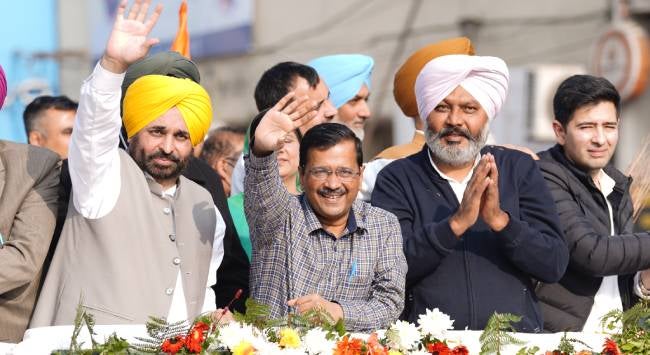Summary
This paper assesses the potential impact of the Aam Aadmi Party’s victory in Punjab by analysing the reasons underpinning its victory and the challenges it will face in governing Punjab.
The Aam Aadmi Party (AAP) registered a landslide victory in the Punjab state elections earlier this month. Winning 92 out of 117 seats is a major achievement for a party only established a decade ago and particularly so in a state where the political scene has been monopolised by the Indian National Congress and the Shiromani Akali Dal (SAD). Moreover, as a state that is sensitive to encroachments upon regional autonomy, Punjab has traditionally been wary of ‘outside’ political parties. This has fed speculation over the impact of AAP’s victory in the upcoming state elections and the national election in 2024. To assess the potential impact of the Punjab election, we need to analyse the key reasons underpinning AAP’s victory and the challenges it will face in governing Punjab.
Economic disillusionment and the demand for better public services proved to be key issues in the election. There was a general view amongst voters that the incumbent Congress-government had performed well on issues relating to infrastructural development and governance. There was, however, widespread dissatisfaction pertaining to education, healthcare and employment. According to The Hindu-CSDS-Lokniti Punjab post-poll survey, 88 percent of voters lamented that unemployment rates had gone up, and a majority were unhappy with the existing healthcare system. Thus, AAP’s promise of adapting its ‘Delhi Model’ in Punjab played an important role in its victory. AAP, which has been in power in Delhi since 2015, has developed a model of governance and provision of welfare services it terms the ‘Delhi Model’. A major aspect of this is the mohalla (neighbourhood) clinics that provide basic health services for free. Hundreds of these primary health centres have been established across the capital. AAP has also invested heavily in reforming the education system. These initiatives range from improving school infrastructure to expanding teacher training facilities and developing resource-rich specialist schools. Other aspects of the ‘Delhi Model’ include providing water and electricity at subsidised rates. AAP has also moved to hire and regularise more sanitation workers.
The appeal of the ‘Delhi Model’ enabled AAP to stitch together a broad voter base. Instead of being limited by caste fault lines, it consolidated its support amongst the Jat farmers and attracted the support of the Dalit groups. Punjab has a large Dalit population that has thus far remained politically marginalised. During this election, the Congress had attempted to consolidate the Dalit vote by appointing Charanjit Singh Channi, a Dalit Sikh, as the Chief Minister four months before the elections. While the Congress held on to Dalit votes in parts of the Doaba region, AAP seems to have received wide-scale Dalit support in the more populous Malwa region. Apart from its focus on public services and welfare, AAP’s policies regarding sanitation workers in Delhi could have contributed to their gaining support amongst the Balmiki and Mazhabi castes, a substantial number of whom work as sanitation workers. Both of these groups have a strong presence in the Malwa region.
Infighting amongst the Congress, coupled with serious allegations of corruption against leading figures of the Congress and SAD, further aided the AAP. However, the party would not have been able to capitalise on this if it had not built a strong organisational base. In 2017, AAP won fewer seats than anticipated because a weak ground game failed to turn enthusiasm into votes. This time round, the party built a strong organisational presence in the urban centres and villages.
There are, however, important differences between the economy of Punjab and Delhi that will pose challenges to AAP fulfilling its promises. Unlike Delhi, Punjab is primarily an agricultural state. AAP will immediately be confronted by discontent amongst the farmers over the rural procurement system and the stagnation of their incomes. The latter is due, in part, to the depletion of groundwater as a result of massive overproduction of paddy. There is also an urgent need for crop diversification. Moreover, Punjab has a limited revenue base and empty coffers. In 2021, 54 per cent of the state’s tax revenue was spent on repaying its debt. Punjab’s declining economy is further evident from the fact that small and medium industries are leaving Punjab for states like Himachal Pradesh.
The new government will need to fix Punjab’s economy to implement the ‘Delhi Model’. To do this, it may also need to contend with an internal issue. Various sectors of Punjab’s economy are monopolised by syndicates that limit revenue remittance to the state. These “mafias” – as they are popularly known – are deeply entrenched within the political circles. While AAP has promised to usher in badlaav (change) and the reign of the aam admi (common man), 69 per cent of its winning candidates have declared assets above ₹1 crore (S$179,259) and 57 per cent of them have criminal cases registered against them.
AAP has declared that it will use its victory in Punjab as a springboard in other upcoming state elections. It will no doubt seek to replicate its success in building a broad voter base around the delivery of public services and welfare. Its ability to do this will rest on its success in overcoming the challenges it will face in governing Punjab and demonstrating that it can adapt the ‘Delhi Model’ beyond the capital.
. . . . .
Associate Professor Iqbal Singh Sevea is the Director of the Institute of South Asian Studies (ISAS), an autonomous research institute at the National University of Singapore (NUS). He can be contacted at isasiss@nus.edu.sg. The author bears full responsibility for the facts cited and opinions expressed in this paper.
Photo Credit: Arvind Kejriwal’s Twitter
-
 More From :
More From :
-
 Tags :
Tags :
-
 Download PDF
Download PDF



